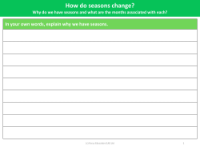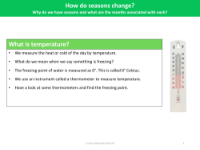Why do we have seasons? - Seasonal Change - Year 1

Science Resource Description
The occurrence of seasons is a result of the Earth's tilt on its axis. In England, as well as other parts of the world, this tilt causes the Earth to lean towards the Sun at certain times of the year and away at others. During the winter months, the Earth tilts away from the Sun, leading to the Sun being lower in the sky. This tilt results in shorter days and longer nights, as the angle of the Sun's rays is more oblique, providing less direct sunlight and warmth. The shortest day, known as the Winter Solstice, typically occurs around December 21st.
Conversely, in the summer, the tilt of the Earth brings it closer to the Sun, making the days longer and the nights shorter. The Sun's rays strike the Earth more directly, which means more hours of daylight and increased warmth. The longest day of the year, the Summer Solstice, happens around June 21st. To help children visualise this concept, using a globe can be an effective teaching tool. It demonstrates the changing amounts of sunlight received during different times of the year, thereby explaining why we experience longer sunny periods in the summer and shorter ones in the winter.







